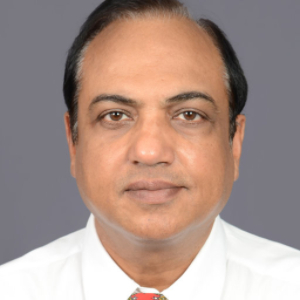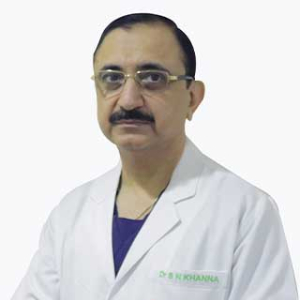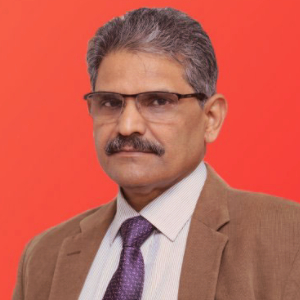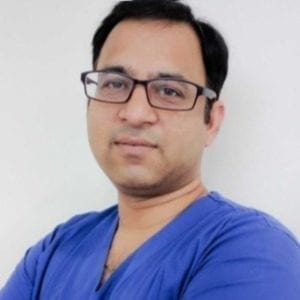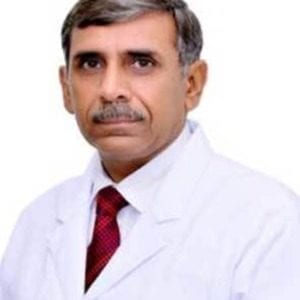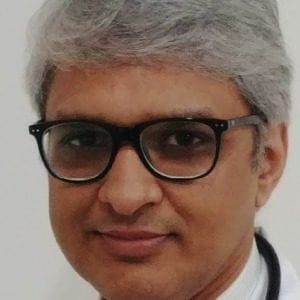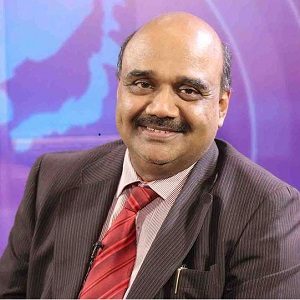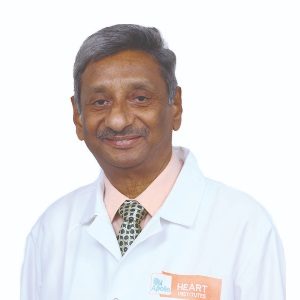Best Doctors for Aortic Aneurysm Surgery in India
- Top Cardiac Surgeon | Kokilaben Hospital, Mumbai, India
- 36+ Years Experience
- Kokilaben Dhirubhai Ambani Hospital
Profile Highlights:
- Dr. Nandkishore Kapadia is one of the leading Cardiothoracic and vascular surgeons in India excelling in heart and lung transplant surgeries.
- He has 36+ years of experience in the field during which he has performed over 10000 CABGs, 2000 heart valve repairs, and 800 minimally invasive cardiac surgeries.
- He has also performed more than 5000 open heart surgeries, 200 heart and lung transplant surgeries, and 150 VAD and ECMO implantation procedures.
- Top Cardiac Surgeon | Fortis Escorts, New Delhi, India
- 26+ Years Experience
- Fortis Escorts Heart Institute New Delhi
Profile Highlights:
- Dr. Surendra Nath Khanna is a leading cardiovascular and thoracic surgeon specializing in minimally invasive cardiac surgeries, heart valve repairs, and heart failure surgeries.
- Dr. Surendra Khanna has 26+ years of experience in cardiac care and has performed more than 17000 surgeries that include beating heart surgery, mitral and aortic valve surgery, and double valve replacement surgery.
- His expertise lies primarily in adult cardiac surgeries and has done some of the most complex cardiac surgeries in India
- Cardiac Surgeon, Mumbai, India
- Over 30 years’ experience
- Jaslok Hospital and Research Centre, Mumbai
Profile Highlights:
- Dr. Suresh V Joshi is a cardiac surgeon in Mumbai with expertise in undertaking complex surgeries as a result of congenital heart diseases.
- He holds an extensive experience of over 3 decades in cardiac surgery and specializes in Coronary Artery Bypass Grafting (CABG); specifically Beating Heart CABG and Minimally Invasive Cardiac Surgeries.
- He is an expert in all kinds of coronary and interventional cardiac procedures and has performed over 15,000 cardiac surgeries for different kinds of heart defects and disorders.
- Cardiac Surgeon, New Delhi, India
- Over 30 years’ experience
- Manipal Hospitals, New Delhi
Profile Highlights:
- Dr. Yugal Kishore Mishra is a well-known cardiovascular and thoracic surgeon in Delhi specializing in Minimally Invasive and Robotic cardiac surgeries.
- He has 3 decades of experience in CTVS and has performed more than 19,000 open heart surgeries to date that including various types of minimally invasive cardiac procedures such as the port access approach for valve surgery and ASD closure.
- He is the founder of the Robotic Cardiac Surgery Program at Fortis Escorts Heart Institute where he has performed over 500 robotic cardiac surgeries.
- Cardiac Surgeon, Gurugram, India
- Over 15 years’ experience
- Narayana Superspeciality Hospital, Gurugram
Profile Highlights:
- Dr. Rachit Saxena is an experienced cardiac surgeon, who is known for his extreme dedication to his profession, and for providing absolute patient satisfaction.
- Supported by an efficient cardiac surgical team, Dr. Saxena is known for successfully managing the most complex of cardiac surgical problems.
- Dr. Rachit Saxena is known especially known for the capability to perform cardiac surgery with minimal blood requirement and ensure early mobilization and return to work.
- Cardiovascular Thoracic Surgeon, Gurugram, India
- Over 27 years’ experience
- Max Super Specialty Hospital, Saket, New Delhi
Profile Highlights:
- Dr. Sandeep Singh is an esteemed cardiac surgeon with over three decades of experience in Cardio-Thoracic and Vascular Surgery (CTVS).
- He currently serves as the Senior Director and Head of CTVS at Max Healthcare.
- Dr. Singh’s educational background is equally impressive, with an MBBS and MS in General Surgery from S.N. Medical College, Agra, and an M.Ch. in CTVS from the L.P.S. Institute of Cardiology, Kanpur.
- Cardiologist, Gurugram, India
- Over 20 years’ experience
Profile Highlights:
- Dr. Vivek Chaturvedi is a highly experienced and acclaimed cardiologist with over 20 years of experience.
- He has performed more than 2500 cardiac ablations, several of them for complex arrhythmias like atrial tachycardia, ventricular tachycardia, VPC, and atrial fibrillation using the latest technology like 3D Electroanatomic mapping.
- He has more than 50 publications in international journals & books.
- Cardiothoracic Surgeon, Chennai, India
- Over 25 years’ experience
- Apollo Hospitals Greams Road
Profile Highlights:
- Dr. T Sundar is one of the best cardiothoracic surgeons in India.
- He is having extensive exposure to critical heart diseases and he has operated on them successfully.
- Dr. T Sundar is a Senior Consultant at Apollo Hospitals since 2003.
- He has been associated with international standards of surgery and diagnosis since his education period.
- Top Cardiothoracic and Vascular Surgeon | Apollo Hospital, New Delhi, India
- 36+ Years Experience
- Indraprastha Apollo Hospital, New Delhi
Profile Highlights:
- Dr. N Sastri is a renowned cardiothoracic surgeon in India with extensive experience in critical heart surgeries.
- He has nearly 36 years of experience and is a senior consultant- Cardiothoracic & Vascular Surgery with Indraprastha Apollo Hospitals, New Delhi.
- Dr. Sastri specializes in the diagnosis and treatment of vascular disorders using advanced techniques. He has expertise in Total Anomalous Pulmonary Venous Connection Repair, Arterial and Ventricle Defects Surgery, Cardiac Resynchronization Therapy, Balloon Valvuloplasty, CABG LV restoration, PDA Device Closure, PPI, Valve Replacement, and Atrial Fibrillation Surgery.
- Over the years’ Dr. Sastri had treated patients across various countries. In addition to the adult and neonatal cardiac surgeries, he is involved in research and put out many research papers in different medical journals.
- Interventional Cardiologist, Chennai, India
- Over 38 years’ experience
- Apollo Hospitals Greams Road
Profile Highlights:
- Dr. I Sathyamurthy is a veteran Cardiologist and has an experience of more than 38 years in Interventional Cardiology.
- Dr. Immaneni Sathyamurthy is a distinguished personality who bagged Padma Shri, the fourth-highest Indian civilian award. In addition to it, he was conferred many awards for his contribution to the medical sciences.
- He has over 250 publications to his credit, some of these are used as textbooks in medical courses.
Best Hospitals for Aortic Aneurysm Surgery in India
Abdominal Aortic Aneurysm (AAA)
Abdominal Aortic Aneurysm (AAA) is the inflammation or swelling of the aorta which is the largest artery of the body. Large aneurysms are rare but are fatal if they burst. It runs from the heart to the abdomen through the chest and is the largest vessel in the human body. A rupture of the AAA can cause bleeding that may be life-threatening.
Types of Abdominal Aortic Aneurysm
The size and the speed of growth of an Aneurysm are the key factors for the classification.
- Small (<5.5 cm): These are slow-growing Abdominal Aortic Aneurysms with a comparatively lesser risk of rupturing than the larger aneurysms. Regular abdominal ultrasounds are often helpful in monitoring these aneurysms.
- Large (>5.5 cm): These are fast-growing Abdominal Aortic Aneurysms that have high chances of rupturing. There might be internal bleeding due to rupture followed by other major complications. The larger the size of the aneurysm, the higher the chances of treating the same through the surgery.
Symptoms of Abdominal Aortic Aneurysm
In most cases, a small abdominal aortic aneurysm shows no symptoms. However, a larger AAA may cause pain or a pulsating feeling in the abdomen & persistent back pain. As it grows slowly without showing any visible symptoms, it is often difficult to detect an Abdominal Aortic Aneurysm. While some aneurysms stay small without any rupture, many others grow large.
They may notice a few symptoms if they have an Abdominal Aortic Aneurysm that continues to enlarge. These symptoms may include back pain, deep and persistent pain in the abdomen, and a pulsating feel near the belly button. It also includes clammy skin, nausea, shock, and vomiting.
A ruptured abdominal aortic aneurysm may cause:
- Dizziness
- Sweaty skin
- Rapid heartbeat
- Shortness of breath
- Loss of consciousness
Causes & risk factors of Abdominal Aortic Aneurysm
- Age: Increasing age is a risk factor for abdominal aortic aneurysms.
- Gender: AAAs are most common in men aged over 65.
- Smoking: Tobacco contains substances that damage the aortic wall.
- Atherosclerosis: In atherosclerosis, there is the narrowing of the arteries due to the accumulation of plaque. These plaques cause the widening of the aorta so that the blood keeps on flowing leading to the weakening of the aorta.
- High blood pressure: It increases the pressure on aortic walls. This may weaken the walls of the aorta and cause damage to the same.
- Family history: Having a family history of AAA may increase the risk of developing it.
- Infection in the aorta: A fungal or bacterial infection may cause an Abdominal Aortic Aneurysm.
- Blood vessel diseases: Some diseases may cause inflammation in the blood vessels.
- Trauma: An injury or trauma may also cause an Abdominal Aortic Aneurysm.
Risk factors for Abdominal Aortic Aneurysm
- Family history: If you have a family history of an Abdominal Aortic Aneurysm, you are at an increased risk of developing the condition.
- Tobacco use: Tobacco consumption can increase your chances of developing an Abdominal Aortic Aneurysm.
- Color complexion: People with white or fair color complexion have a risk of developing abdominal aortic aneurysms.
- Other types of aneurysm: If you have an aneurysm in some other blood vessel, it may increase your risk for Abdominal Aortic Aneurysm.
Diagnosis of Abdominal Aortic Aneurysm
Routine physical examination
Abdominal MRI
Ultrasound
Abdominal CT scan
Treatment options for Abdominal Aortic Aneurysm
Medical monitoring
Treatment of Large AAA
Endovascular surgery
During endovascular surgery, a small incision is made in the groin through which a graft made of metal mesh is inserted & advanced to the swollen aorta. This graft is sealed to the aortic wall at both ends which reduces the risk of bursting.
Open surgery
Treatment of small or medium AAA
For a small (3.0-4.4cm) or medium (4.5-5.4cm) aneurysm, surgery may not be recommended as it may not benefit the patient. The patient is called for regular check-ups (every year in case of a small aneurysm and every three months in case of a medium aneurysm) & scans to monitor the size of the aneurysm.
The patient is advised to prevent the aneurysm from getting bigger, which is done by:
- Stopping smoking
- Eating a balanced diet
- Maintaining a healthy weight
- Regular exercise
Complications of Abdominal Aortic Aneurysm
A ruptured aneurysm or aortic dissection (or tear) in the layers of the Aortic wall are the major complications. The larger the size and speed of growth of the aneurysm, the higher are the chances of Aneurysm rupture which may cause bleeding, which is life-threatening.
You will realize a ruptured aneurysm if you have low blood pressure, sudden and continuous abdominal pain, or a faster pulse. A tearing sensation or back pain also signifies the rupture of an aneurysm.
Prevention Of Abdominal Aortic Aneurysm
There are various ways of preventing and worsening Abdominal Aortic Aneurysm. These, does not limit to but, may include:
- Quitting the consumption of tobacco and smoking may help prevent aneurysms.
- Maintain normal blood pressure and cholesterol by following the instructions of the doctor.
- Eating a healthy and balanced diet that includes fruits and vegetables is also helpful.
- Exercising regularly with the right activities advised by the doctor may also help prevent aneurysms.

